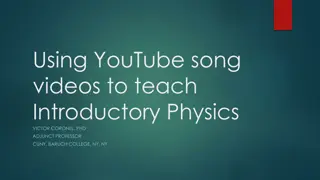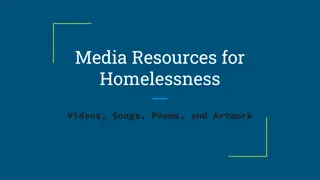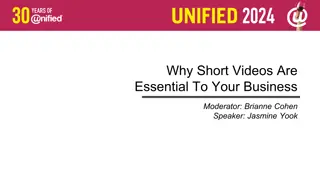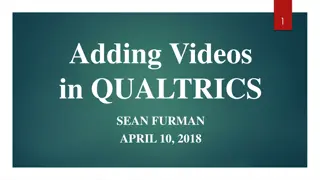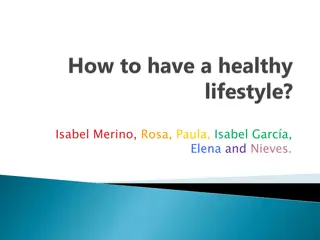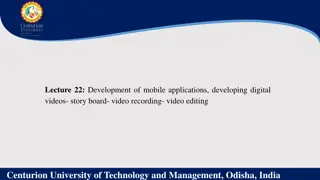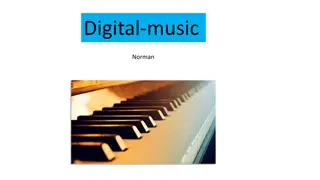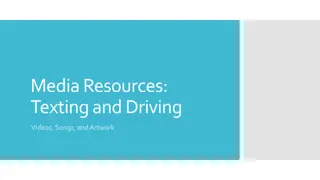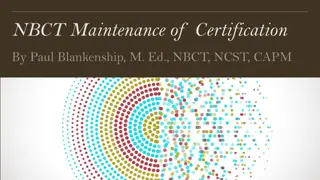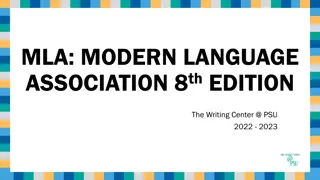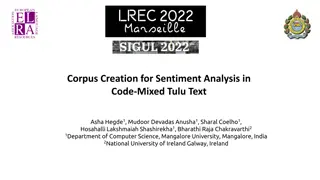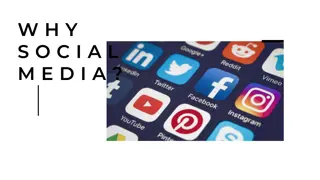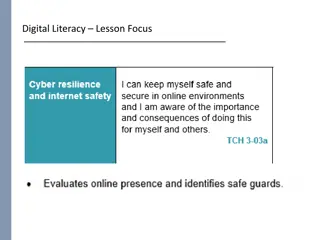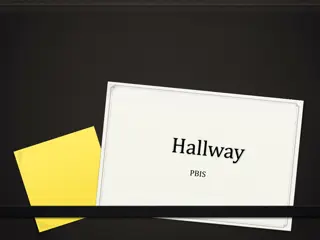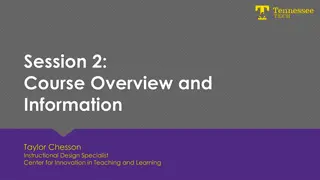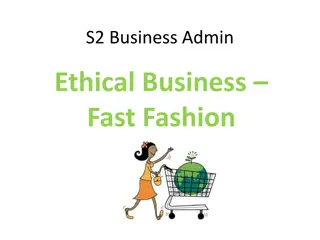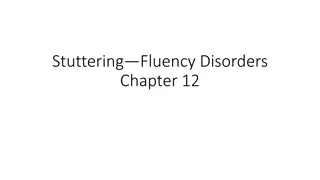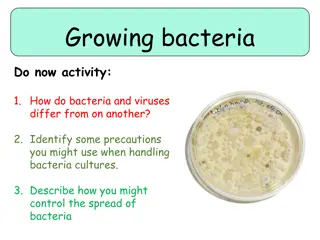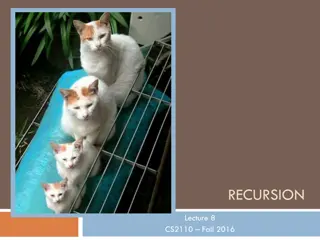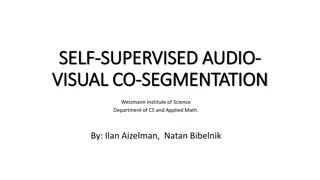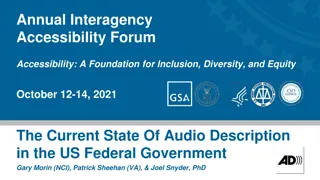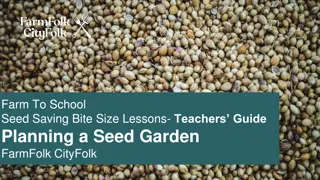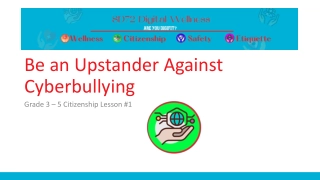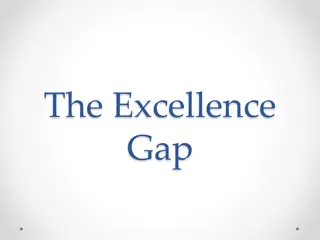Viralizing YouTube Videos: Key Insights and Strategies
YouTube, a giant in user-generated video content, offers immense potential for videos to go viral. Understanding the dynamics of viralization on YouTube is crucial for content creators. This chapter delves into the phenomena of viral videos on YouTube, explores key factors that contribute to a video going viral, and highlights notable examples like Gangnam Style. Learn about YouTube's analytics tools and the addictive nature of its recommendation system that keeps viewers engaged for hours. Discover how to tap into viral potential and enhance your video's reach on the platform.
Uploaded on Sep 11, 2024 | 0 Views
Download Presentation

Please find below an Image/Link to download the presentation.
The content on the website is provided AS IS for your information and personal use only. It may not be sold, licensed, or shared on other websites without obtaining consent from the author. Download presentation by click this link. If you encounter any issues during the download, it is possible that the publisher has removed the file from their server.
E N D
Presentation Transcript
Chapter 9 Viralizing Video Clips How do I viralize a YouTube video?
Introduction YouTube dominates the market of user-generated video content Viralization what exactly does it take for a video to become viral YouTube viewing is an example of [information spread creates dependencies]
YouTube was founded in February 2005 by three former PayPal employees In November 2006, it was acquired by Google People watch videos on YouTube so much that the site became a search engine second in size only to Google itself Addictive nature of recommendation sidebar brings viewers through a continuous stream of relevant short-clips for up to hours at a time before they click out of it 9.1 YouTube and Viralization 163 Average daily video view count 400 hours worth of new content was being uploaded every single minute, which is almost 66 years of content per day Illustration 2 Depiction of the months between 2009 and 2012 where the average number of video views per day on YouTube hit another billion. As of October 2015, YouTube had reached just under 5 billion views. By late 2015, more than 1 billion peoplewere visiting YouTubeeach day and registeringalmost 5billion videoviews. 400hours worth of new content were being uploaded to YouTubeevery single minute, which is almost 66 years of content per day (in other words, if you collected all the videos that will be uploaded in the next 24 hours, it would take you 66 years of your life to watch it all!) YouTube has really become a viral phenomenon itself, like videos on its site aim to become. Viral Style What makes videos go viral? This question doesn t have a simple an- swer, but that hasn t prevented people from studying it. We talked in Part III of the book about how websites can capture and store the actions that users make on the site. YouTube is no ex- ception: they can log user behavior, including interactions with their video player. Thisdata can beanalyzed to seehow peoplewatch videos and which videoshavegoneviral. Someof YouTube sanalytic toolsfor highlighting overall viewing behavior, such as YouTubeInsight, have been made available for public access too. What is the most notorious video that achieved the status viral? That would be Gangham Style, a four-minute music video by the artist PSY. Released in July 2012, Gangham Style became the first video ever to break 1 billion views, which it did in just fivemonths (by December 2012). It proceeded to hit the 2 billion mark in under two years (by May 2014). The graph of its views over time, provided by YouTube s analytics, can be seen in Illustration 3. Since 2013, twelve other YouTube videos have also broken the 1 bil- lion barrier. Second to Gangham Style in view count as of early 2016
Viral Style What makes videos go viral? YouTube logs user behavior, including interactions with their video player This data is analyzed to see how people watch videos and which videos have gone viral YouTube Insight analytic tools 1st video achieving viral status? Gangnam Style by PSY released in July 2012: 1st video ever to break 1 billion views in 5 months; it proceeds to hit 2 billion mark by May 2014 Viral Videos on YouTube 164 Illustration 3 Aggregate views over time for the music video Gangham Style by PSY, on YouTube. This was the first video ever to reach 1 billion views. was Taylor Swift s Blank Space , with 1.3 billion views. Gangham Style was, at the time of this writing, still the only video to have hit two billion. In fact, when it surpassed 2,147,483,647 views in Decem- ber 2014, YouTube appeared to have literally lost count, as the value displayed on the main page came to a grinding halt. Why did YouTube stop counting at this seemingly random number? This value is the largest that can be taken using 32 bits of storage, which istheamount that YouTubehad reserved for theview counter of each video. Nobody ever anticipated that a singlevideo would amassso many views that 32 bits would no longer be enough. YouTube quickly fixed this problem by upgrading to a 64-bit counter, giving them a new maximum of 9,223,372,036,854,775,808. So until PSY, Swift, or someone else reaches the quintillions, YouTube s counter will be safe. Bringing viewers to videos How does a video like Gangham Style get so popular? We can start by looking at the four main paths by which may lead a viewer to a particular YouTube clip in the first place: a search with terms the video is tagged with, on sites like Google, a referral from e.g., email, Facebook, or ads promoting the video, being subscribed to the YouTube channel that posts the video, and a recommendation to the video given in YouTube s sidebar. Subscription and recommendation often play a bigger role in de- termining a video s popularity than the number of likes and dislikes it has. Subscription is straightforward to understand, but how does YouTubegenerateitsrecommendations?Doesit usea collaborativefil- tering algorithm likeNetflix doesfor recommending movies?Or maybe a PageRank-style algorithm to rank the clips by importance? It turnsout that neither would translateto thisapplication well. Un- like Netflix movies, YouTube videos are typically short in their length
Viral Style (as of 2016) Since 2013, 12 other videos have also broken 1 billion barrier Second to Gangnam Style in view count as of early 2016 was Taylor Swift s Blank Space with 1.3 billion views Gangnam Style was still the only video to have hit two billion When it surpassed 2,147,483,647 views in December 2014, YouTube appeared to have literally lost count, as the value displayed on the main page came to a grinding halt Why? 32-bit counter: 231-1
Bring Viewers to Videos How does a video get so popular? 4 main paths may lead a viewer to a particular YouTube clip in the first place a search with terms the video is tagged with, on sites like Google a referral from e.g., email, Facebook, or ads promoting the video a subscription to YouTube channel that posts the video a recommendation to the video given in YouTube s sidebar Subscription and recommendation play a bigger role in deciding a video s popularity than # of likes/dislikes it has How does YouTube generate its recommendations?
Bring Viewers to Videos Does YouTube use a collaborative filtering algorithm like Netflix does for recommending movies? Does it use PageRank-style algorithm like Google to rank clips by importance? Neither algorithm translate well to YouTube Why? Unlike Netflix movies, YouTube videos are typically short in length and lifecycle, and have variable viewing behavior make it hard to establish consistent system for users rating clips For PageRank approach, need to link clips together somehow, e.g., by searching a video s description for hyperlinks to other clips or by comparing tags between videos for matches in keywords tags and descriptions can be rather unreliable in quality YouTube video recommendation is different, and much simpler
Bring Viewers to Videos We learned in Chapter 8 about co-participation - weighted links between students by their co-participation in discussion threads, and vice versa YouTube keeps track of co-visitationcount for pairs of videos, i.e., the number of times both videos were watched by a viewer in some recent time window, say past 24 hours Weighted video-to-video graph YouTube seems to take co-visitation graph and combines it with match of keywords in the video title, tags, and summary to generate recommendations Often only those videos with watch- count similar to, or slightly higher than (why?), that of current video are shown in recommendation positive feedback (making widelywatched videos to become even more widely watched)
Defining Viral What is exactly is meant by viral? total views over time looks like curve (c) Three important features high total view count rapid increase of sufficient (long) duration (sometimes) short time before rapid increase begins Viral Videos on YouTube 166 ? Total? views? (c)? ? High? total? ? No golden formula to guarantee a video will become viral ? (b)? ? ? (a)? ? ? ? Time? Rapid? increase? starts? fast? Rapid? increase? lasts? long? ? ? Illustration 5 Typical shapes observed for the total number of views on a video over time. (a) stays at a low level. (b) rises very quickly, but then flattens out rapidly too. (c) has a reasonably rapid increase of long duration, and stays that way for a while. its total views over time looks something like curve (c) in Illustration 5. There are three important features here: 1. A high total view count. 2. A rapid increase of sufficient duration. 3. A short time before the rapid increase begins. Thereisno golden formula you can follow toguaranteeyour videowill becomeviral. It sasmuch of an art asa science. Still, modelsthat have been developed for information spread can give interesting insight into why viralization may occur. These models have been used to ana- lyze the spread of items ranging from physical product to diseases through populations. Thinking of items asYouTubevideos, wewill soon look at one simple yet elegant model for information spread. Popularity Let s think about thefactorsthat attract peopleto an item in thefirst place. One, of course, is the intrinsic value that the item brings to a person. Some may like it, regardless of what others think about it. In many instances, though, a person sdecision to obtain an item will depend on others. A network e ect, as it s called, can occur for one of two reasons. First, the value of a service or product may depend on the number of people who use it. What use would a telephone be to you if nobody else had one? Would Facebook still be interesting if you were the only person that used it? These products and services have
Popularity Models that have been developed for information spread can give insight into why viralization may occur Subjects of information spread models have analyzed spread of items ranging from physical products to diseases through populations Factors that attract people to an item in the first place??? intrinsic value that the item brings to a person - some may like it, regardless of what others think about it in many instances, a person s decision to obtain an item will depend on others network effect
Network Effect Network effect for two reasons 1. value of service or product may depend on the number of people who use it examples of phone and FaceBook positive network effect - as more people use them, they become more valuable to each individual 2. knowing what others think about an item can affect your decision have you ever watched a movie because your friends told you that it was good, irrespective of whether it is the genre you typically like? peoples opinions and decisions are influenced by others the crowds are no longer wise , because assumption of independence no longer holds. What results instead is fallacy of crowds
Popularity Both intrinsic value and network effect apply to a person s choosing to watch a video on YouTube YouTube site itself does have a positive network effect Which one is more influential? 9.2 The Fallacy of Crowds: Information Cascade 1. intrinsic value of the clip to the person (whether it matches her preferences) 2. fallacy of crowds (whether she sees/knows a lot of other people watching it) 167 network effect that spread video viewing through population, and hence has a larger impact on a video going viral Intrinsic Value Network Effect Need to quantify network effect Illustration 6 Two factors a ecting the popularity of a YouTube video are its intrinsic value (i.e., match between the video and a person s taste) and the network e ect (i.e., a person seeing that others have watched the video), a positive network e ect: as more people use them, they become more valuable to each individual. Second, knowing what others think about an item can a ect your decision. Haveyou ever watched a moviebecause your friends told you that it was good, irrespective of whether it is the genre you typically like? In thesesituations, peoples opinions and decisions areinfluenced by others. The crowds are no longer wise as they were in Part III, becausetheassumption of independencethat wemadethere no longer holds. What results instead is the fallacy of crowds. Which of these applies to a person choosing to watch a video on YouTube? The site itself does have a positive network e ect, but that doesn t really havea bearing on whether someonewill chooseto watch a particular video. More profound are the other two components (see Illustration 6): the intrinsic value of the clip to to the person (i.e., whether it matches her preferences), and the fallacy of crowds (i.e., whether she sees a lot of other people watching it). The latter is based on a network e ect that will spread the video viewing through the population, and therefore has a larger impact on a video going viral. Quantifying network e ects is no easy task. They are dependent on the individual, the item, and the situation of interest. In this chapter, wearegoing to study a model for information cascade, which is one example of the fallacy of crowds. 9.2 The Fallacy of Crowds: Information Cascade What would you do if you saw someone standing on a street corner looking up at the sky? You would probably think shehad a nose bleed
Fallacy of Crowds Quantifying network effects is no easy task dependent on individual, item, and situation of interest Model for information cascade Example of information cascade What would you do if you saw someone standing on a street corner looking up at sky? Thinking the person has nose bleed, and go on with your business What if you saw tenpeople standing together looking up at the sky? Probably stop and look, thinking that something may be wrong This makes the crowd even bigger, so the next person passing by will see 11 people, which is even more convincing to stop and look
Information Cascade People follow actions of the crowd, and ignore their own internal reasoning Information cascade arises when [independence assumption about opinions (which is behind the wisdom of crowds) breaks down] Instead of complete independence in decision-making, decisions become completely dependent on what has happened before Positive feedback in sequential decision making e.g.:stock market bubbles, fashions, Volvo s epic split, etc.
Information Cascade You are more likely to stumble upon a video that is already popular Even if the video doesn t match your taste, you may be compelled to see what it s all about You might decide to stop viewing it if you don t like it, but this will still count towards the viewing number shown next to the video, and partially determines its place on the recommendation page A higher view count will in turn influence more people, and this accumulation keeps on building
Making Decision in Sequence What process will eventually trigger an information cascade? Sequential decision making - each person gets a private signal (e.g., my nose starts bleeding) and releases a public action (e.g., tilt my head to the sky) Subsequent users can observe public action, but not private signal When there are enough public actions of the same type (e.g., ten people looking at the sky), then all later users will ignore their own private signals and simply follow what others are doing At this point, a cascade has been triggered . Key question of ? how many public actions are enough?
Making Decision in Sequence How many public actions are enough to trigger a cascade depends on situation probably much harder to get everyone to watch your YouTube video than it is to get people to look up at the sky A cascade can accumulate to a large size through positive feedback more people display the same public action gives the next person more incentive to follow, which makes the group larger, thereby creating more incentive, etc. positive feedback feeds off its own unabated influence, generating more influence, and continues to grows larger
Making Decision in Sequence vs. negative feedback, which systematically counteract an effect to reach an equilibrium in network (through, e.g., distributed power control or usage-based pricing) Is public action right or wrong? could be either everyone is looking up, but there is nothing of interest in the sky is wrong an example of fallacy of crowds Cascade is fragile: even if a few private signals are leaked to the public (one person shouts I am looking up the sky because I have a nosebleed), the cascade can quickly disappear or even reverse direction. Why? Since people are following the crowd, they have little faith in what they are doing, even though many are doing the same thing
Number-guessing thought Experiment A group of people lined up to play a game in which they will guess one number The moderator has picked either 0 or 1 to be the (single) true number One at a time, each person comes up to a blackboard, where she is to write down what she think (guess) the number is The moderator has two cards, one of which has a 0 written on it, and one of which has a 1 When a person comes up, the moderator shows him/her a card, with either 0 or 1 written on it serving as the person s private signal There s no guarantee that the number a person is shown will be right, but everyone is told that there s a higher chance that the card they are shown is right than wrong If the true number is 0, the moderator has a chance, say 80%, of showing the 0 card, 20% of showing the 1 card If the true number is 1, the moderator has a chance, say 80%, of showing the 1 card, 20% of showing the 0 card 0 1 80% 0 20% 1 0 80% 1 20% Each person s guess written on blackboard is her public action When a person making a guess, she gets to see public actions of everyone who guessed before her, but she does not get to see private signals they were shown
Number-Guessing thought Experiment Consider 1st person Alice; what should she do? There s nothing currently on blackboard, so all she has to write (public action) is the number on the card (private signal) shown to her [she knows this number is more likely to be right than wrong] Consider 2nd person Bob; how is his situation different from Alice s? Not only does Bob see [both public action that Alice wrote (PUB I) and his own private signal (PRV II)], he also knows how Alice reasoned Bob cannot see Alice s private signal, but he knows it must be the same as PUB I, because Alice had no other information when she guessed. So Bob really knows two private signals, PRV I and PRV II if they are both 0, then obviously Bob will write down 0 if they are both 1, then similarly, Bob will write down 1 when different, randomly choose 0 or 1
Number-Guessing thought Experiment Now, here comes the first chance of an information cascade starting . When 3rd person Cara goes up to board, what does she know? she is shown a private signal (PRV III) on a card she sees public actions of first two users (PUB I and PUB II) on blackboard Cara needs to compare PUB I and PUB II If they are different, Cara knows Alice s and Bob sprivate signals must have been different, too; Bob must have seen a mismatch and guessed randomly. These two conflicting private signalscancel out, leaving Cara (3rd) in exactly the same shoes that Alice the 1st person was. Cara would then just guess based on her own private signal, PRV III the 4th person will be in the same shoes as Bob 3rd person
Number-Guessing thought Experiment If PUB I and PUB II are the same (OO or 11) if Cara s PRV III matches, then it s a no-brainer: she knows two private signals(hers and Alice s) saying her number, and another (Bob s) which could have matched. So, Cara should pick this number for PUB III EVEN IF Cara s PRV III doesn t match PUB I and PUB II, it turns out that her best guess is to ignore her private signal and go with the public action anyway So, if first two people(e.g., Alice and Bob) write down the same guess, then an information cascade starts. The 3rdperson s (Cara s) rational choice is just to keep with the crowd If the 3rd person went with the crowd, then the 4th person will, and so on (until something else comes along to break up the cascade)
Number-Guessing thought Experiment Why does a cascade start after first two people? Cara knows what Alice s [first person s] private signal is Given [PUB I = PUB II] PRV III PRV I PRV III & cancel out So Cara s decision comes down to what she can guess about Bob s private signal Going back to Bob s decision, there s two ways in which his public action could have matched Alice s 1. Bob s PRV II matched Alice s PUB I (i.e., Bob sPUB II = Bob s PRV II) 2. Bob s PRV II didn t match Alice s PUB I, but when he chose randomly he landed on PUB I (i.e., Bob sPUB II Bob s PRV II) Which case is more likely? (1) is more likely. So, Cara knows it is more likely than not that Bob is guessing his private signal Therefore, Cara s best bet is to guess whatever PUB II is, and we have an information cascade started ....
Number-Guessing thought Experiment What if no cascade has started after the first two people? Then everything restarts, and a cascade could just as well start after the next two people, and then the next two, and so on All it takes is some even-numbered person to show the same public action as the odd-numbered person right before her
Starting a Cascade How long, can we expect, it will take for a cascade to start? How easy can it be to break a cascade? [Emperor s New Clothes] The first pair of guessers Alice and Bob constitute the first pair of people to guess Assume that moderator has decided on 1 as the correct number, and that the chance that she shows each person a 1 as their private signal is 80% (termed moderator s chance) Enumerate different types of cascades by a tree diagram 1 All six possible scenarios arising from private signals of first two guessers IC
Starting a Cascade 1 Alice getting (and guessing) 1 [PUB I = 1] Bob getting 0 reasoning that Alice got 1 Bob flipping a coin and guessing 1 [PUB II = 1] Starting a correct cascade of 1
Starting a Cascade 1 When will there be no cascade at the end of their turns? For this to happen, PUB I PUB II What is the probability that no cascade will have been triggered at the end of their turns? P(PUB I = 0 & PUB II = 1) + P(PUB I = 1 & PUB II = 0)
Starting a Cascade 1 The probability that moderator shows each person a 1 as his/her private signal is 80% Probability of Alice getting (and guessing) 0 0.2 Probability of Bob getting 1 0.8 Probability of Bob flipping a coin and guessing 1 0.5 P(PUB I = 0 & PUB II = 1) = 0.2 * 0.8 * 0.5 = 0.08
Starting a Cascade 1 The probability that moderator shows each person a 1 as his/her private signal is 80% Probability of Alice getting (and guessing) 1 0.8 Probability of Bob getting 0 0.2 Probability of Bob flipping a coin and guessing 0 0.5 P(PUB I = 1 & PUB II = 0) = 0.2 * 0.8 * 0.5 = 0.08
Starting a Cascade 1 Probability that no cascade will have been triggered at the end of Alice s and Bob s turns = P(PUB I = 0 & PUB II = 1) + P(PUB I = 1 & PUB II = 2) = 0.08 + 0.08 = 0.16
Starting a Cascade Probability that a cascade will occur? (1 0.16) = 0.84 Probability of a correct cascade [11] = 0.64 + 0.08 = 0.72 probability of both Alice and Bob getting 1 = 0.8 * 0.8 = 0.64 probability of Alice s PRV I = 1 and Bob s PRV II = 0 and flipping a coin to get 1 = 0.8 * 0.2 * 0.5 = 0.08 Probability of incorrect cascade [00] =0.08 + 0.04 = 0.12
Starting a Cascade 72% (0.72) is pretty high. Why? Assumption that moderator, with 80% chance, shows the correct private signal (1) to each person If we lower it, both incorrect cascade and no cascade would become more likely
Future Pairs of Guessers After Alice and Bob, the chance of no cascade is 16% (8% + 8%) How about after Cara (3rd person), then? The third person cannot by herself trigger a cascade; if none was triggered after Bob (and Alice), then Cara starts from scratch with no information, effectively in Alice s shoes So after the first three people, the probability of no cascade is still 0.16 How about after Dana (4th person)? 9.3 Starting and Breaking a Cascade 175 Probability of No Cascade 100% 16% 2.56% 0.41% 16% 2.56% 0.41% A B C D E F G Pair 1 Pair 2 Pair 3 Illustration 14 In the number-guessing experiment, as more pairs of people have guessed, the chance we won t wind up in a cascade gets lower. These probabilities are for a moderator s probability of 80%. that? It all goes back to the assumption we made about the modera- tor at the beginning: there s an 80% chance that she shows the correct private signal (1) to each person. That s a pretty high probability. If we lowered it, both the incorrect cascade and no cascade would be- come more likely. For more on this relationship, and a more detailed calculation breakdown, check out Q9.1 and Q9.2 on thebook swebsite. Future pairs of guessers After Aliceand Bob, thechanceof no cascadeis16%. How about after Cara, then? Remember that the third person cannot herself trigger a cascade; if nonewastriggered after Bob, then Cara startsfrom scratch with no information, e ectively in Alice sshoes. So after thefirst three people, the probability of no cascade is still 16%. How about after Dana? Now wehave two ways that a cascade could be triggered: first after Alice and Bob, and then after Cara and Dana. To have no cascade at the end, we need the first pair and the second pair to not trigger one. So we multiply the chance of each not causing one: 0.16 0.16 = 0.0256, or 2.56%. After Dana, then, there s more than a 97% chance that we will be in a cascade. Then how about after Ed? As the first person in the third pair, he cannot causea cascade, so thechancestaysthesame: 2.56%. And after Frank? Now we have three chances of a cascade: after Bob, Dana, and Frank. Sowemultiply threetimes: 0.16 0.16 0.16 = 0.0041, or 0.41%. That s a very small chance. You probably see the pattern by now, shown in Illustration 14. To compute the chance of still having no cascade after N pairs, we mul- tiply 0.16 N times. For five pairs, it becomes 0.16 0.16 0.16 0.16 0.16 = 0.000105, i.e., less than one-hundredth of a percent. For 50 pairs, the decimal has 37 zeros before the first significant digit!
Future Pairs of Guessers For the first 4 persons, we have two ways that a cascade could be triggered: first after Alice and Bob, and then after Cara and Dana To have no cascade at the end (of Dana), we need the first pair and the second pair to not trigger one Multiply the chance of eachpair not causing one: 0.16 x 0.16 = 0.0256 (2.56%) After Dana, then, there s more than a 97% chance that we will be in a cascade 9.3 Starting and Breaking a Cascade 175 Probability of No Cascade 100% 16% 2.56% 0.41% 16% 2.56% 0.41% A B C D E F G Pair 1 Pair 2 Pair 3 Illustration 14 In the number-guessing experiment, as more pairs of people have guessed, the chance we won t wind up in a cascade gets lower. These probabilities are for a moderator s probability of 80%. that? It all goes back to the assumption we made about the modera- tor at the beginning: there s an 80% chance that she shows the correct private signal (1) to each person. That s a pretty high probability. If we lowered it, both the incorrect cascade and no cascade would be- come more likely. For more on this relationship, and a more detailed calculation breakdown, check out Q9.1 and Q9.2 on thebook swebsite. Future pairs of guessers After Aliceand Bob, thechanceof no cascadeis16%. How about after Cara, then? Remember that the third person cannot herself trigger a cascade; if nonewastriggered after Bob, then Cara startsfrom scratch with no information, e ectively in Alice sshoes. So after thefirst three people, the probability of no cascade is still 16%. How about after Dana? Now wehave two ways that a cascade could be triggered: first after Alice and Bob, and then after Cara and Dana. To have no cascade at the end, we need the first pair and the second pair to not trigger one. So we multiply the chance of each not causing one: 0.16 0.16 = 0.0256, or 2.56%. After Dana, then, there s more than a 97% chance that we will be in a cascade. Then how about after Ed? As the first person in the third pair, he cannot causea cascade, so thechancestaysthesame: 2.56%. And after Frank? Now we have three chances of a cascade: after Bob, Dana, and Frank. Sowemultiply threetimes: 0.16 0.16 0.16 = 0.0041, or 0.41%. That s a very small chance. You probably see the pattern by now, shown in Illustration 14. To compute the chance of still having no cascade after N pairs, we mul- tiply 0.16 N times. For five pairs, it becomes 0.16 0.16 0.16 0.16 0.16 = 0.000105, i.e., less than one-hundredth of a percent. For 50 pairs, the decimal has 37 zeros before the first significant digit!
Future Pairs of Guessers How about after Evan (5th person)? As the first person in the third pair, Evan cannot cause a cascade, so the probability of stays the same is 2.56% After Frank (6th person)? We have had three chances of a cascade (after Bob, Dana, and Frank) so the probability of not having a cascade = (0.16)3 = 0.0041 = 0.41% [a very small chance of not having a cascade] 9.3 Starting and Breaking a Cascade 175 Probability of No Cascade 100% 16% 2.56% 0.41% 16% 2.56% 0.41% A B C D E F G Pair 1 Pair 2 Pair 3 Illustration 14 In the number-guessing experiment, as more pairs of people have guessed, the chance we won t wind up in a cascade gets lower. These probabilities are for a moderator s probability of 80%. that? It all goes back to the assumption we made about the modera- tor at the beginning: there s an 80% chance that she shows the correct private signal (1) to each person. That s a pretty high probability. If we lowered it, both the incorrect cascade and no cascade would be- come more likely. For more on this relationship, and a more detailed calculation breakdown, check out Q9.1 and Q9.2 on thebook swebsite. Future pairs of guessers After Aliceand Bob, thechanceof no cascadeis16%. How about after Cara, then? Remember that the third person cannot herself trigger a cascade; if nonewastriggered after Bob, then Cara startsfrom scratch with no information, e ectively in Alice sshoes. So after thefirst three people, the probability of no cascade is still 16%. How about after Dana? Now wehave two ways that a cascade could be triggered: first after Alice and Bob, and then after Cara and Dana. To have no cascade at the end, we need the first pair and the second pair to not trigger one. So we multiply the chance of each not causing one: 0.16 0.16 = 0.0256, or 2.56%. After Dana, then, there s more than a 97% chance that we will be in a cascade. Then how about after Ed? As the first person in the third pair, he cannot causea cascade, so thechancestaysthesame: 2.56%. And after Frank? Now we have three chances of a cascade: after Bob, Dana, and Frank. Sowemultiply threetimes: 0.16 0.16 0.16 = 0.0041, or 0.41%. That s a very small chance. You probably see the pattern by now, shown in Illustration 14. To compute the chance of still having no cascade after N pairs, we mul- tiply 0.16 N times. For five pairs, it becomes 0.16 0.16 0.16 0.16 0.16 = 0.000105, i.e., less than one-hundredth of a percent. For 50 pairs, the decimal has 37 zeros before the first significant digit!
Future Pairs of Guessers Probability of still having nocascade after N pairs = (0.16)N This probability is going very quickly to zero After a few pairs, we are more or less guaranteed that we will have a cascade. At this point, the decisions of future people have become entirely dependent on what is on the board already What affects the type of cascade (correct or incorrect)? moderator s chance (probability) itself, irrespective of the number of pairs
Effects of Moderators Probability 100 90 Probability of Outcome (%) 80 70 60 No Cascade Correct Cascade Incorrect Cascade 50 40 30 20 10 0 50 55 60 65 70 75 80 85 90 95 100 Chance a Private Signal is Correct (%) When moderator s probability is 50%, the same chance (~38%) of correct as incorrect cascade, and less of a chance of no cascade As probability increases, chance of correct cascade increases, while that of incorrect and no cascade decrease When it reaches 100%, the outcome is guaranteed to be correct cascade probability increases, the chance of a correct cascade increases, while that of incorrect and no cascade decrease. When it reaches 100%, the outcome is guaranteed to be a correct cascade. Illustration 31: Thisshowshow themoderator sprobability a ectseach out- come s chance of being triggered from the first pair of guessers. On the one extreme, when themoderator sprobability is50%, wehavethesamechance of correct as incorrect cascade, and less of a chance of no cascade. As the at 100%? Here, weareguaranteed to havea correct cascade, for if the moderator alwaysshowed thethecorrect number, we d never havethe fallacy of crowds. Q9.3 What doestherelationship between thenumber of pairsand theprob- ability of an incorrect cascade look like? In Illustration 32, we show how the chance of triggering an incorrect cascade changes with the number of pairs. Each of the curves is for a di erent moderator sprobability (50% to100%). At 80%, for example, we seethat it goes from 12% after one pair (as we found in our calcu- lation before) to just under 15% after three pairs, and then stays the same. We notice this same trend in most of the cases: the probability jumps for the first few pairs, and is then more or less constant. What does this tell us about whether the cascade will be correct or incorrect? Notice that the vertical axis on the graph only goes up to 50%. An incorrect cascade always has less than 50% chance of occur- ring, meaning that a correct cascade is always more likely. Still, the
The Emperors New Clothes It is easy to start a cascade. Once triggered, how long will one last? Forever, unless there is some kind of disturbance, e.g., a release of private signals How many disturbances would it take to break a cascade? A few will often suffice, no matter how long the cascade has been going on Despite the number of people involved, everyone knows that they are just basically playing a game of following the leader to maximize their chance of guessing correctly The Emperor s New Clothes effect encapsulates the fragility of an information cascade
The Emperors New Clothes 19th century story by Hans Christian Anderson in which a vain emperor is told that his new clothing is of the finest fabric, invisible only to those who are unfit for their positions In reality, there are no clothes at all. While everyone plays along (i.e., their public actions), not wanting to seem unfit (i.e., their private signals), it only takes one kid s shouting hey, he is wearing nothing at all! before everyone becomes more confident that the emperor is truly disrobed in public
The Emperors New Clothes In the context of number-guessing experiment. how do we break a cascade? Suppose a cascade of 1 s has started after the first pair Some time later, it s Frank s turn to guess, and he gets a 0 as his private signal. As his public action, he guesses 1, but he also shouts out that his private signal was 0 Now, Greg is up, and he also gets a private signal of 0. He has the following information about private signals on the one hand, there s at least one (private) 1, from Alice. But he cannot be sure if Bob had a (private) 1, because Bob could have gotten a 0 and flipped on the other hand, there s at least two 0 s: his and Frank s So, what will Greg guess? 0, because there s more evidence of this being correct This breaks the cascade .
In the number-guessing experiment, it only takes two people to start a cascade More generally, the size of the crowd needed to cause a person to ignore their instinct is dependent both on (i) scenario and (ii) individual Also, the most overarching assumption made is that everyone acts rationally - everyone can, and will, decide what the best guess to make is depending on the information they have but most people do not go through all of this probability thinking on the spot in their heads
From Cascade to YouTube How can we translate sequential decision making to viralizing a YouTube video? Not easy, but the main idea is clear you want your video to undergo an information cascade, so that when a person sees or hears about it (i.e., the public action), they will most likely watch it, irrespective of whether or not it matches her intrinsic interest (i.e., her private signal) How many public actions does it take before a person will watch your video automatically? Does such a number even exist? Even if it does, it will be different for everyone, depending on how malleable the person is All interesting questions without clear answers



